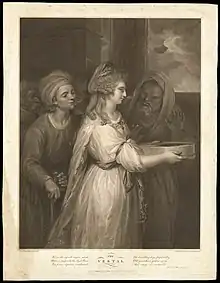Tuccia
Tuccia (3rd-century BC[1]), was an ancient Roman Vestal Virgin.

She is known for the case in which her chastity was questioned by a spurious accusation. When the piety of holy men and women was doubted by sceptics, the gods could perform miracles to vindicate them. In Tuccia's case she utilized a flat perforated basket to carry water, without the water falling to the ground through the sieve.
Tuccia's decision to prove her innocence is recounted:
- O Vesta, if I have always brought pure hands to your secret services, make it so now that with this sieve I shall be able to draw water from the Tiber and bring it to Your temple (Vestal Virgin Tuccia in Valerius Maximus 8.1.5 absol).
Tuccia proved her innocence by carrying a sieve full of water from the Tiber to the Temple of Vesta [Augustine, De Civitate Dei, X, 16, in Worsfold, 69].
The Vestal Tuccia was celebrated in Pliny the Elder's Natural History (28: 12) and Petrarch's Triumph of Chastity in Triumphs. However, in Juvenal's Satire VI (famously renamed 'Against Women') he references her as one of many lascivious women.
Sieve Iconography
By the late Middle Ages, the image of Tuccia and her sieve became associated with the virtue of chastity. Paintings of chaste women would often include a sieve and this symbol figures prominently in many depictions of England's "Virgin Queen" Elizabeth I in the late sixteenth century.[2]
See also
References
| Wikimedia Commons has media related to Tuccia. |
- Robin Lorsch Wildfang: Rome's Vestal Virgins
- ffolliott, Sheila (2003). "Portraying Queens: the International Language of Court Portraiture in the Sixteenth Century". In Ziegler, Georgianna (ed.). Elizabeth I: Then and Now. Washington DC: Folger Shakespeare Library. p. 170. ISBN 029598323X.